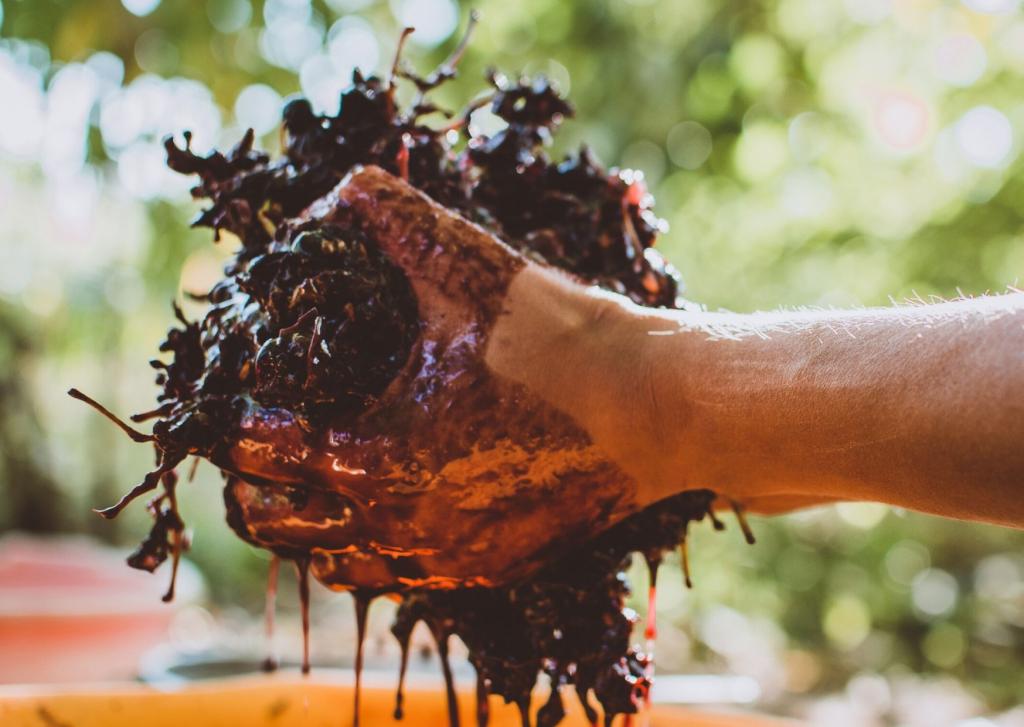All you need to know about
Grappa, Marc and Fine
under 10 minutes
A grappa is an Italian spirits made from the distillation of grape pomace. Pomace is the leftover from wine making, discarded grape seeds, stalks and stems. Grappa has been around since the Middle Ages in Italy. Marc and fine are also both distillates made from by-products of the winemaking process, but from France.
Grappa
The geography and the history of Grappa
Although in Bassano del Grappa there are some important distilleries, the name “grappa” does not derive from this town, but probably from “graspa”, the dialect word for grappa in the North-East of Italy; “graspa” comes from “graspo”, that in dialect is a vine shoot.
Grappa can only be made in Italy (almost)! Grappa is a protected name in the EU.
To be called grappa, the following criteria must be met:
— the production should happen in Italy or in the Italian part of Switzerland or in San Marino
— the spirit must be produced from pomace
— the fermentation and distillation must occur on the pomace—no added water
Some regions of Italy even have their own PGI such as Grappa di Barolo, Grappa del Piemonte, Grappa del Veneto.
The use of the word grappa for products distilled in the United States is still allowed, and refers as to Pomace Brandy, specifically grappa or grappa brandy.
How is Grappa made?
The ingredients to make Grappa
The raw material vinaccia (= grape skins) is crucial to the final quality. The vinaccia must be of good quality, fresh and moist, which often means a quick transfer from winery to distillery. Prolonged contact with the air will produce off-notes in the spirit. Moreover the vinaccia must be stem-less because stems will produce methanol.
This means working closely, also physically, to the best winemakers nearby the distillery, for a top quality grappa, to make sure you obtain the best possible base products. The yields in grappa are very low at the end. Nonino family obtain around 20-25 litres from 450 kilos of pomace or vinaccia.
Most of the time, the aromatic grape varieties such as Muscat or Gewürtztraminer and also pomace from wines of Amarone or Barolo that give body, sugar and a certain form of sweetness are used.


The fermentation of Grappa
The skins from both black and white grapes can be used but the fermentation will be different. Indeed white skin varieties have been pressed out of the grape juice before it became wine. They have not undergone fermentation, therefore the pomace contains no alcohol, just skins, seeds and some flesh. As said earlier the stems must be taken away as they not only produce tannins and undesirable bitter flavours but also methanol.
The fresh pomace, before it dries out, is fermented with yeasts. After fermentation is complete, the „pomace wine“ is distilled.
Black skins have undergone alcohol fermentation so it already contains some alcohol, since the red wine had skin contact during fermentation. Therefore it can be distilled immediately.
In general, the pomace from black grape varieties gives more interesting aromas and is less likely to produce high levels of methanol. The pomace from white grape varieties gives higher acidity and balances the red element, but can run the risk of higher methanol levels.
The distillation of Grappa
Both pot and column stills are used.
Initially it was carried out by direct flame (and often in the vineyards itself*) now it is distilled either….
-in a series of batch in continuous stills (for mass produced low quality products). The pomace can be fed in a continuous stream into extractors that strip off the vapour. This then passes into a standard linked column-still set-up. Using this method gives a higher alcohol strength of the final spirit.
-in pot stills. You have to be careful when using pot still method, because excess heat can cause the solid matter to burn on the surface of the heater, producing off-notes
-al bagno maria (bain-marie). Distillers will either use a double-walled pot with a cooling water running in the space between, or place the vinaccia in baskets with perforated bottoms.
Today in Italy, less than 100 grappa distillers use the pot still method of distillation, and their products accounts for only 18 percent of the grappa made in Italy.
The spirit reaches up to 85% before being diluted, reduced to about 40 to 45 percent alcohol before being bottled.
*Was stopped because it was often distilled directly and with the stems which lead to the presence of methanol production. Methanol produces bad intoxication and can be lethal. Now that the distillation happens in another location, time is taken to remove the stem.
After distillation, grappa is usually stored in glass bottles for about six months to a year before it is distributed.
Maturation and ageing of Grappa
Traditionally all grappa were clear, unaged spirits. Today, a few aged, mostly for short period to add complexity. Many kind of woods are used to achieve different flavour profiles and styles.
If wood aged the grappa can claim it as such:
–Vecchia or Invecchiata (minimum of 12 months in wood)
–Riserva or Sravecchia (minimum of 18 months in wood)
The styles of Grappa
The flavor profile of grappa depends on the grape varietal used.
Occasionally, a producer will add a little syrup or herbs. This sweeter Grappa is particularly popular on the American market. But usually grappa is dry.
Single variety vs. blend?
Grappa can either be made from a mixture of pomaces from different sources, or from one grape variety. Some floral and aromatic grapes, like Moscato or Viogner work well on their own as do some fragrant black grapes. Chardonnay however is less impressive. If at least 85% of the pomace comes from a single variety, the grappa can be designated di vitigno or varietale, and the type of grape can be incorporated into the name of the grappa.
Equally, a blend of varieties can produce a grappa with greater complexity.
The single variety grappas are actually quite recent. Nonino was the first producer of a grappa obtained from a single variety, in 1973, while in the past it was absolutely common to mix different pomace to obtain grappa.
Today grappa obtained from a single variety, lilke Grappa Moscato, Prosecco, Chardonnay, Merlot, or Picolit, and grappa obtained using the pomace of a single, popular wine, like Sassicaia, Tignanello, etc….are very much looked after. However, the best wines don’t always produce the best grappa; as the grappa is made from the leftovers of the winemaking process, the more the wine takes out of the pomace, the less remains for the grappa.
A variety of flavoured grappas are also available, including some with a hint of almond, honey or blueberry and Nardini’s Acqua di Cedro, a grappa-based liquor made with cedro.
Fine & Marc
Differences
The taste:
Marc is finer as Fine.
The base material:
Marc is the result of the distillation of the solid matter (skins, pips, etc.) from the grape pressing after the alcoholic fermentation.
Fine comes from the distillation of the wine lees collected at the bottom of the barrels after maturation.
Similarities
Made with similar winemaking or distillation processes
Made from any grapes.
Neither of these appellations specifies which grape varieties may be used as the base; any variety permitted under a Burgundy appellation law is allowed (for Marc and Fine de Bourgogne, that will be other grapes in Alsace for example). Most often following grapes are used : Chardonnay and Gamay or Pinot Noir.
Producers usually prefer white grapes for most red wines go through a long maceration process that extracts all the color, tannins and flavor from the skins, and there’s not much left for the distiller to work with.
Does the best wine make the best Fines? and the best Marcs?
Not necessarily. It is said that „ poorer vintages sometimes produce better marc, perhaps because the winemaker exerts greater care in pressing the grapes in the first place“.
How are Fines and Marcs made?
Base material and fermentation
Marc’s base material are the solid matter resulting from the grape pressing after the alcoholic fermentation such as skins, pips, etc.
Fine’s base material are wine lees collected at the bottom of the barrels after maturation.
Neither of these appellations specifies which grape varieties may be used as the base; any variety permitted under a Burgundy appellation law is allowed.
Distillation processes for Marcs and Fines
Please read the class about grappa to have more information about the distillation processes used.
Many producers prefer grapes which have had the « rafle « (the stalk) removed before vinification, in other words, destemmed. This base material, rich in aromas, is then distilled in a pot still often in a single pass. To give good marcs : very good and fresh must is necessary.
Maturation and ageing for Marcs and Fines
So far it is identical to the grappa produced in Italy.
But it differs in one aspect: unlike Grappa, Marc and Fine are always aged in wood, taking on a rich, tawny color. The alcohol collected after distillation, with an alcohol degree of around 52 %, will then spend many long years in cellars, where it will age in oak barrels and vats of various sizes, ensuring the future complexity of the spirit, and ist originality. The temperature and the humidity in the cellar where the marc is kept is crucial
If the cellar is too humid as it ages the alcohol disappears but not the volume, and the marc gets feeble, too dry, and volume diminishes but not the alcohol, and the marc is overwhelmed by tannins.
After this long, patient ageing period, which can last for decades, the Marcs and Fines are finally blended.
Marcs are released after two years oak ageing minimum. Most of the producers keep their Marcs from 8 to 40 years, especially in the wine regions with a strong peasant culture.
Fine are named “Vieille”, “Très vieille” or “Hors d’âge”, after 3,6 et 10 years of oak maturation.
FYI:
It is better to drink quickly after bottling as it no longer ages in the bottle.
How does it taste ?
Because only dry skins and pips are used to make Marc de Bourgogne, the resulting spirit has less of a fruity character and is much more reliant on mouthfeel than on flavors.
RESOURCES/SOURCES FOR FINE, MARC, AND GRAPPA
The Drunken Botanist, Amy Stewart
Alcools, André Dominé
Distilled Knowledge, Dave Broom
Of course Wikipedia

